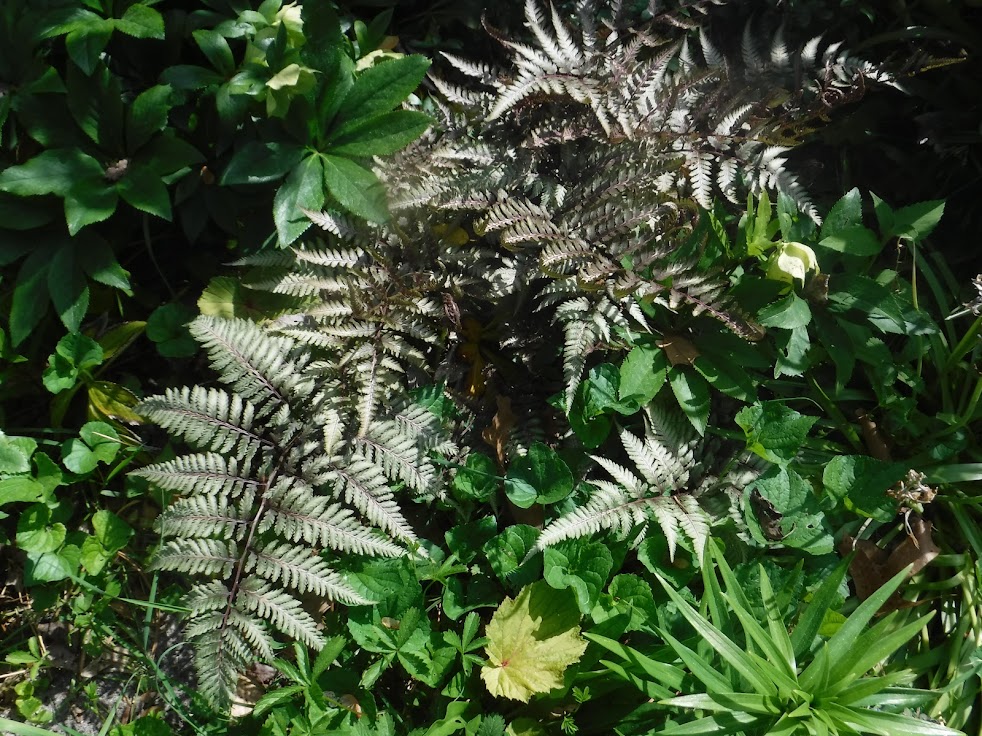Bogturtle's Garden- 5/11 to 19, 2023
Athyrium japonicum, the Japanese Painted Fern is in many places on the property, but this is the largest sample, among all, and in the main perennial bed.
Tradescantia virginiana, I think. The Spiderwort, named for either the filaments in the middle of each flower or the clear strands of sticky sap that comes if you break a stem. Ordered from Lamb's nursery, which is famous, but long out of business, to my knowledge. Available in many colors from them, in named varieties, but all have long blended and the common deep violet is most frequently seen here. But any shade might show up, and this is a pale lavendar. A grand addition, but also a too successful plant here. Constantly weeded out, with having to just break the soft stems off at ground level, usually 2x. So an easily managed weed.
The yellow is the flowering part of Arum italicum, with a ghostly green part easily seen. The spadix? I only have this plant for the neat foliage, that may die down later into the Summer, but endures all Winter.
Very high up, but I am impressed by the vigor of this shrub.
Calycanthus 'Hartlidge Wine' at its best.
Quite a plant explorer story behind this clone of Styrax japonica 'Emerald Pagoda'. From Korea, I think, but growing in Japan and China, also.
Two Styrax growing by the barn. The nearer is the native from our South, S. opaca, and harder to see, the smaller leaved S. japonica.
Here are the flowers of S. Opaca. And lessons in botany are illustrated by how flowers are often the indicator of relationships more than leaves. The flowers on both Styrax seem almost identical, while the leaves are quite different in size. But the other is that here we have two little trees, one from the Orient and the other from our South that clearly show how temperate regions in both continents were, somehow, connected. Climate change, and of a much warmer time, clearly. Many similar species and Genera show this.
The post at one corner of the pool deck is totally buried in Lonicera sempervirens 'Magnifica' and Bignonia capreolata, the Crossvine. I think it is B. c. 'Miss Jeckyl'.
The date is inaccurate. This was collected 5/13. The Catbird is nesting really close by. Most interesting to me is that the Swamp Milkweed, Asclepias incarnata 'Alba' in the pot, has come back. Grown from seed planted last Summer, it may be in too much shade to bloom. I have a number of others. The seed packet said to chill the seed or let it go through Winter, as some seeds need that conditioning to sprout. I planted them when they arrived in July and they sprouted easily. I don't know if the company had pre-chilled them. I doubt that.
For reasons unknown, this common Butterfly is called a red spotted purple. This one was flitting around alone, seeming to want to sit soaking up the Sun. I found alot of them easy to photograph on the stones where we park the vehicles, one Summer. The small black fruit had fallen off our native Wild Black Cherry, Prunus serotina, that overhangs the area and running the vehicles in had crushed some. I think the fruit had fermented and the insects were flitting around erratically and super sluggish. I think some were drunk.







%20-%20Copy.JPG)


















.JPG)
Comments
Post a Comment